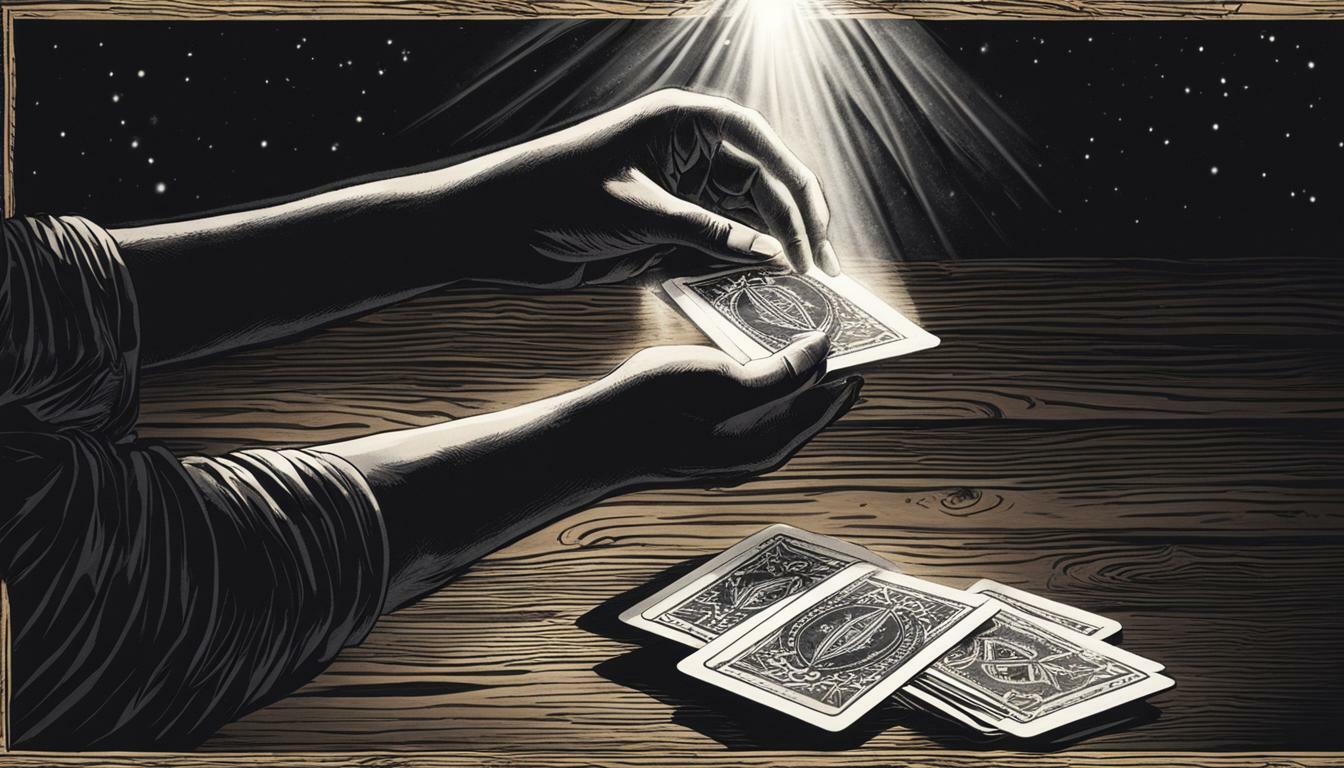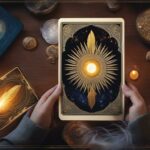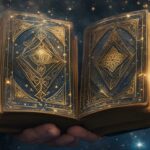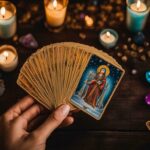Are you curious about how to use tarot cards to uncover the mysteries in your life? In this guide, we will explore tarot card reading tips and beginner tarot spreads to help you tap into your intuition and gain insights into your decisions.
Key Takeaways:
- Tarot cards can be a powerful tool for self-discovery and reflection.
- Understanding the history and different types of tarot cards is essential for effective use.
- Choose a tarot deck that resonates with you and speaks to your intuition.
- There are different types of tarot readings, such as general readings, question readings, and past-present-future readings.
- To read tarot cards, set your intention, shuffle the cards, lay them out in a spread, and interpret their meanings.
Now that you have an overview, let’s dive into the world of tarot cards and discover the magic they hold. Whether you’re a beginner or have some experience, this guide will provide valuable insights and techniques to enhance your tarot card reading skills.
Understanding Tarot Card Meanings
Before diving into tarot card readings, it’s essential to understand the meanings and interpretations behind each card in the deck. Tarot cards can be a powerful tool for self-discovery and reflection, but knowing the significance of each card is key to unlocking their wisdom.
A standard tarot deck consists of 78 cards, divided into the Major Arcana and the Minor Arcana. The Major Arcana cards represent major life events and themes, while the Minor Arcana cards represent everyday aspects of life. Each card has its own symbolism, imagery, and associated meanings.
When exploring tarot card meanings, it’s important to consider both the traditional interpretations and your own intuitive understanding. While there are common interpretations for each card, your personal connection to the images and symbols can bring additional layers of insight.
Key Concepts:
- Major Arcana: Represents major life events and themes
- Minor Arcana: Reflects everyday aspects of life
- Symbols and Imagery: Each card contains unique symbolism and imagery
- Intuition: Trust your own intuitive understanding of the cards
Exploring tarot card meanings is a fascinating journey of self-discovery. Take the time to study each card, reflecting on its symbolism and how it resonates with your own life experiences. Keeping a tarot journal can be immensely helpful, allowing you to record your interpretations, observations, and any patterns that emerge over time.
Remember, tarot readings are not about predicting the future, but rather gaining insights into your present situation and potential paths ahead. By understanding the meanings behind each tarot card, you can tap into the wisdom they hold and embark on a transformative journey of self-discovery and personal growth.
Tarot Card Meanings Table:
| Card | Meaning |
|---|---|
| The Fool | New beginnings, spontaneity, leap of faith |
| The Magician | Manifestation, resourcefulness, mastery of skills |
| The High Priestess | Intuition, mystery, divine knowledge |
| The Empress | Nurturing, abundance, fertility |
| The Emperor | Authority, stability, structure |
| The Hierophant | Tradition, conformity, spiritual guidance |
| The Lovers | Love, relationships, choices |
| The Chariot | Willpower, determination, forward movement |
| The Strength | Inner strength, courage, resilience |
| The Hermit | Soul-searching, introspection, solitude |
Choosing the Right Tarot Deck
With the vast array of tarot decks available, it’s important to find one that aligns with your intuition and speaks to your personal connection. Each deck has its own unique symbolism and artwork, so take the time to explore different options and see which one resonates with you the most.
When choosing a tarot deck, consider the theme or aesthetic that appeals to you. Some decks feature traditional symbolism, while others may have a more modern or abstract interpretation. Do you prefer vibrant colors or a more muted palette? Are you drawn to decks with a specific cultural or spiritual influence? These are all factors to consider when making your selection.
To help you make an informed choice, here is a table showcasing popular tarot decks and their characteristics:
| Deck Name | Symbolism | Aesthetic | Intended Use |
|---|---|---|---|
| The Rider-Waite Tarot | Traditional | Vibrant | Beginners, general use |
| The Wild Unknown Tarot | Nature, animals | Minimalistic | Intuitive readings |
| The Modern Witch Tarot | Empowerment, modern life | Contemporary, diverse | Female empowerment |
Remember, the most important aspect of choosing a tarot deck is finding one that speaks to you on a deeper level. Trust your intuition and allow yourself to be drawn to the deck that resonates with your energy. Once you have found the perfect deck, it can become a powerful tool for self-reflection and guidance on your spiritual journey.
Different Types of Tarot Readings
Tarot readings come in different forms, each offering unique perspectives and insights into your life’s questions and situations. Whether you’re seeking guidance on love, career, or personal growth, there’s a tarot reading technique that can help you find the answers you’re looking for. Here are a few popular types of tarot readings:
- General Readings: These readings provide an overall view of your life, offering guidance on various aspects like love, career, and personal development. They can help you gain a broader understanding of your current situation and the energies surrounding you.
- Question Readings: If you have a specific question or issue in mind, a question reading can help you gain clarity and insight. Focus on a specific question or concern, and the cards will provide guidance and possible outcomes.
- Past-Present-Future Readings: This type of reading delves into your past, present, and future, allowing you to understand how past experiences have influenced your current situation and what lies ahead. It can provide valuable insights into your life’s journey and help you make informed decisions.
During a tarot reading, the reader will lay out the cards in a spread, which is a specific arrangement of cards that represents different aspects of your question or situation. Each card’s position in the spread adds depth and nuance to its interpretation. Popular spreads include the Celtic Cross, the Three-Card Spread, and the Relationship Spread.
Remember, while tarot readings can offer guidance, they should not be seen as definitive predictions. The cards reflect the energies and possibilities surrounding you at the given moment, but it’s ultimately up to you to make choices and shape your own future.
| Card | Meaning |
|---|---|
| The Fool | Beginnings, spontaneity, and taking risks |
| The Emperor | Authority, leadership, and stability |
| The Lovers | Love, relationships, and choices |
| The Death | Transformation, endings, and new beginnings |
| The Star | Hope, inspiration, and spirituality |
As you explore the world of tarot readings, remember to keep an open mind and trust your intuition. The cards are a tool to help you connect with your inner wisdom and gain deeper insights into your life. Whether you choose to consult a professional tarot reader or read for yourself, the journey of tarot can be a powerful and enlightening experience.
How To Read Tarot Cards
Now that you have your tarot deck, let’s explore the step-by-step process of reading the cards and uncovering their messages. Reading tarot cards is a personal and intuitive practice that requires connecting with the energy of the cards and trusting your own interpretations. Here’s a breakdown of the essential steps to get you started on your tarot journey.
Step 1: Set Your Intention
Before diving into a tarot reading, it’s important to set your intention. Take a moment to reflect on what you hope to gain from the reading and the specific questions or areas of your life you want guidance on. Setting a clear intention helps focus your energy and allows the cards to provide meaningful insights.
Step 2: Shuffling and Laying Out the Cards
Once you’ve set your intention, take your tarot deck in your hands and shuffle the cards while concentrating on your question or intention. You can shuffle the deck in any way that feels comfortable to you, whether it’s a traditional riffle shuffle or simply mixing the cards together. Once you feel ready, lay out the cards in a pattern or spread that resonates with you.
There are various tarot spreads you can use, depending on the nature of your question or the type of reading you want. For example, a simple three-card spread can provide insight into past, present, and future aspects of a situation, while a Celtic Cross spread offers a more in-depth analysis. Experiment with different spreads and find ones that feel meaningful to you.
Step 3: Interpretation and Trusting your Intuition
With the cards laid out, take a moment to study each card’s symbolism and imagery. Refer to a tarot card guide or book if needed, but remember that your intuition plays a crucial role in interpreting the cards’ messages. Trust your gut feelings, impressions, and the emotions that arise as you look at each card. As you gain experience, you’ll develop a personal connection with your deck and a unique understanding of the cards’ meanings.
Remember that tarot readings are not set in stone predictions but serve as a tool for self-reflection and guidance. The cards reflect the energy and possibilities surrounding your situation at the time of the reading. Keep an open mind and embrace the insights and messages that the cards reveal to you.
| Key Steps to Reading Tarot Cards: | – Set your intention before the reading | – Shuffle the cards and choose a tarot spread | – Interpret the cards using your intuition | – Embrace the insights and messages revealed |
|---|
Maintaining Tarot Card Energy
To ensure accurate readings and a strong connection with your tarot deck, it’s important to maintain its energy through cleansing and personal rituals. Tarot card cleansing can help remove any residual energies and restore the deck to its natural state. There are several methods you can use to cleanse your tarot cards, including:
- Smudging: Light a bundle of sage or palo santo and pass the cards through the smoke, focusing on releasing any negative or stagnant energies.
- Sunlight or Moonlight: Place your tarot cards on a windowsill or other safe outdoor area where they can absorb the energy of the sun or moon. Leave them there for a few hours or overnight.
- Crystal Clearing: Surround your tarot deck with crystals known for their cleansing properties, such as clear quartz or selenite. Allow the crystals to absorb any negative energy from the cards.
In addition to cleansing, incorporating personal rituals into your tarot practice can further enhance the energy of your deck. These rituals can be as simple as lighting a candle or saying a prayer before each reading. They help create a sacred space and set the intention for your readings.
Sample Ritual: Candle Meditation
“Before each tarot reading, I like to light a candle to create a calm and focused atmosphere. I sit quietly in front of the candle, take a few deep breaths, and visualize any distractions or negative energies melting away. I then set my intention for the reading, asking for guidance and clarity. Once I feel centered, I proceed with the reading, trusting in the energy of the cards and my intuition.”
Remember, maintaining the energy of your tarot cards is a personal and intuitive process. Experiment with different cleansing methods and rituals to find what resonates with you. By regularly cleansing your deck and incorporating your own rituals, you can create a sacred space for your tarot practice and deepen your connection with the cards.
| Cleansing Method | Benefits |
|---|---|
| Smudging | Removes negative energies and purifies the deck. |
| Sunlight or Moonlight | Recharges the cards with natural energy. |
| Crystal Clearing | Utilizes the cleansing properties of crystals to restore the deck’s energy. |
Can I Use Tarot Cards Without Studying Them?
Wondering if you can study tarot cards without actually studying them? Well, the truth is, to effectively use tarot cards, understanding their symbolism and meanings is essential. Without delving into studying tarot cards, your readings might lack accuracy and depth. So, take the time to explore the rich history and interpretations behind each card to unlock their true potential in your readings.
Conclusion
Using tarot cards can be a transformative experience, enhancing your intuition and decision-making abilities. Start your tarot journey today and unlock the mysteries within yourself.
Tarot cards have a rich history and are divided into two main categories: the Major Arcana and the Minor Arcana. The Major Arcana cards represent significant life events and overarching themes, while the Minor Arcana cards reflect the everyday aspects of life. When selecting a tarot deck, it’s important to find one that resonates with you, as this will allow you to connect more deeply with the cards and tap into your own intuition.
There are various types of tarot readings, each offering different insights and perspectives. General readings provide a broad overview of your current situation, question readings focus on specific inquiries, and past-present-future readings shed light on the flow of time and events. By engaging in tarot readings, you can gain valuable guidance and self-discovery.
Reading tarot cards involves a combination of setting intentions, shuffling the deck, laying out the cards in a chosen spread, and interpreting their meanings. While it’s helpful to familiarize yourself with the traditional meanings of the cards, it’s also important to trust your intuition and personal connection with the cards. Keeping a tarot journal can be beneficial, allowing you to track your progress, insights, and patterns over time.
To maintain the energy of your tarot cards, you can incorporate cleansing rituals and personal rituals with your deck. Cleansing can be done through various methods, such as smudging with sage or placing the cards under moonlight. By nurturing the energy of your tarot cards, you create a sacred space for exploration and connection.
Embarking on a tarot journey is a personal and enriching experience. As you delve into the world of tarot, you will deepen your understanding of yourself and the universe around you. Trust your intuition, embrace the wisdom of the cards, and unlock the transformative power of tarot.








